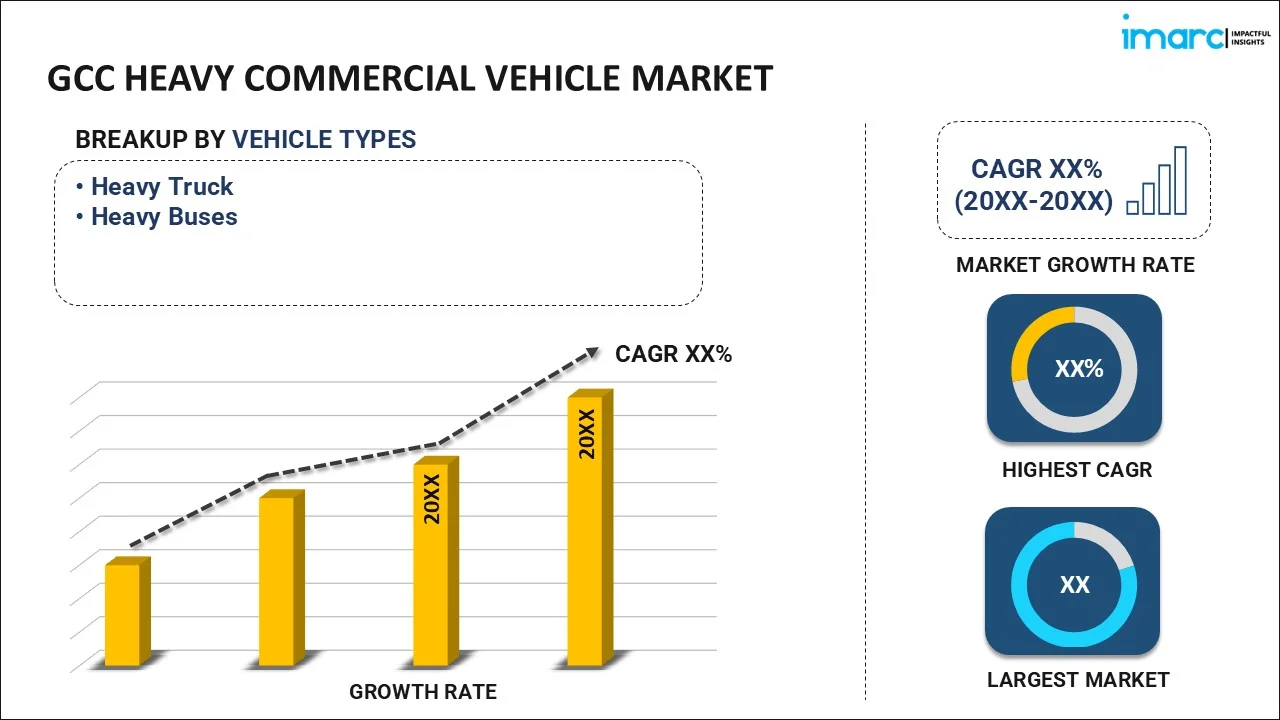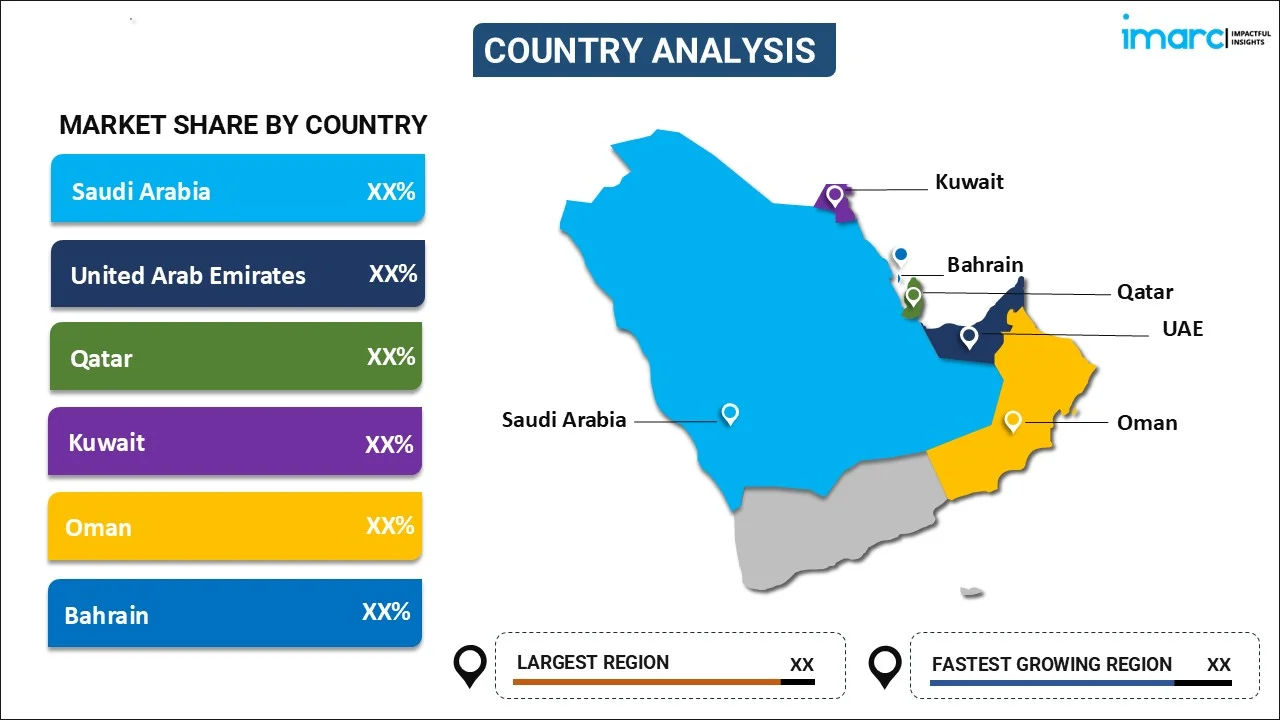
GCC Heavy Commercial Vehicle Market Report by Vehicle Type (Heavy Truck, Heavy Buses), Class Type (Class 7, Class 8), Propulsion Type (Diesel, CNG, Alternate Fuel), End User (Individual, Fleet Owner), Application (Transportation, Construction, Mining, Agriculture, and Others), and Region 2025-2033
GCC Heavy Commercial Vehicle Market Overview:
The GCC heavy commercial vehicle market size reached USD 17.2 Billion in 2024. Looking forward, IMARC Group expects the market to reach USD 27 Billion by 2033, exhibiting a growth rate (CAGR) of 5.10% during 2025-2033. The growing need for efficient logistics and supply chain management, rising implementation of stringent regulations to reduce carbon emissions standards, and increasing demand for fuel-efficient and durable commercial vehicles are some of the factors impelling the market growth.
|
Report Attribute
|
Key Statistics
|
|---|---|
|
Base Year
|
2024
|
|
Forecast Years
|
2025-2033
|
|
Historical Years
|
2019-2024
|
| Market Size in 2024 | USD 17.2 Billion |
| Market Forecast in 2033 | USD 27 Billion |
| Market Growth Rate 2025-2033 | 5.10% |
GCC Heavy Commercial Vehicle Market Trends:
Increasing Demand for Transportation and Logistics Services
With the growing need for efficient logistics and supply chain management in the Gulf Cooperation Council (GCC), heavy commercial vehicles (HCVs) are becoming integral in transporting goods and materials across borders and within urban centers. These vehicles, designed to transport large loads over far distances, are essential for transporting a variety of items, ranging from building materials to goods for consumers. Additionally, rising user expectations for fast and reliable deliveries are encouraging investments in HCVs equipped with modern tracking and efficiency features, supporting streamlined supply chains. In 2024, Al Habtoor Motors unveiled JAC’s latest heavy-duty trucks in the UAE, introducing the PROMATE 2049 and WORKMATE 4146 models. These vehicles showcase Cummins Euro V engines producing around 460 hp and 2300 Nm of torque, catering to the UAE’s diverse industry needs, especially in construction, logistics, and transportation. Both trucks are designed with ergonomic dashboards and air suspension systems, aimed at enhancing driver comfort and reducing fatigue.
Growing Focus on Environmental Sustainability
With the increasing awareness about environmental impact and stricter emission standards, GCC countries are encouraging the adoption of environment-friendly HCVs. Governing bodies in the region are implementing regulations to reduce carbon emissions, promoting a shift towards low-emission and fuel-efficient HCVs. The growing investment in hybrid and electric commercial vehicles, driven by incentives and subsidies that make sustainable fleet options more attractive for logistics and construction companies, is offering a favorable market outlook. This regulatory push aligns with environmental commitments, encouraging businesses to modernize fleets and adopt advanced, fuel-efficient HCVs. In 2024, Volt Mobility in the UAE signed a $210 million purchase agreement with Mullen Automotive for 3,000 electric cargo vans and trucks to be delivered over 16 months. These vehicles will be leased to major GCC clients, including UPS, DHL, and FedEx, supporting the region's clean energy goals and sustainability efforts.
Rising Adoption of Fuel-Efficient and Durable Vehicles
The increasing demand for fuel-efficient and durable HCVs because of the challenging environmental conditions and the need for long-term operational reliability, is supporting the market growth. Businesses in the construction, logistics, and mining sectors are looking for vehicles that can reliably withstand intense workloads while maintaining performance over long distances and under harsh conditions. Manufacturers are responding by launching models with features tailored to meet these demands, such as increased gross vehicle weight (GVW) capacity and extended warranties. These advancements not only improve vehicle performance but also lower operational costs, attracting businesses aiming to maximize asset longevity. Additionally, companies are prioritizing fuel efficiency to manage expenses and meet environmental targets, which is resulting in a preference for vehicles with optimized fuel performance. In 2024, Juffali Commercial Vehicles (JCV) unveiled the eActros and eEconic electric trucks in Saudi Arabia, marking a milestone in the country’s transition to emission-free transportation.
GCC Heavy Commercial Vehicle Market News:
- April 2024: Tata Daewoo announced a partnership with Saudi Diesel Equipment Company (SDEC) and Perfect Arabia Factory (PAF) to establish a truck manufacturing plant in Saudi Arabia. Under the agreement, Tata Daewoo will provide technical support, while SDEC and PAF will jointly assemble Daewoo trucks locally, expanding the commercial vehicle market within Saudi Arabia.
- June 2023: FAMCO launched the first-ever heavy-duty electric truck range by Volvo in the Middle East, aligning with the UAE’s sustainability goals. The Volvo FH electric truck, with a 44-ton capacity and a 300 km range, was unveiled in Dubai and has already been adopted by Unilever for its UAE operation.
GCC Heavy Commercial Vehicle Market Segmentation:
IMARC Group provides an analysis of the key trends in each segment of the market, along with forecasts at the regional and country levels for 2025-2033. Our report has categorized the market based on vehicle type, class type, propulsion type, end user, and application.
Vehicle Type Insights:

- Heavy Truck
- Heavy Buses
The report has provided a detailed breakup and analysis of the market based on the vehicle type. This includes heavy truck and heavy buses.
Class Type Insights:
- Class 7
- Class 8
A detailed breakup and analysis of the market based on the class type have also been provided in the report. This includes class 7 and class 8.
Propulsion Type Insights:
- Diesel
- CNG
- Alternate Fuel
The report has provided a detailed breakup and analysis of the market based on the propulsion type. This includes diesel, CNG, and alternate fuel.
End User Insights:
- Individual
- Fleet Owner
A detailed breakup and analysis of the market based on the end user have also been provided in the report. This includes individual and fleet owner.
Application Insights:
- Transportation
- Construction
- Mining
- Agriculture
- Others
The report has provided a detailed breakup and analysis of the market based on the application. This includes transportation, construction, mining, agriculture, and others.
Country Insights:

- Saudi Arabia
- United Arab Emirates
- Qatar
- Kuwait
- Oman
- Bahrain
The report has also provided a comprehensive analysis of all the major regional markets, which include Saudi Arabia, United Arab Emirates, Qatar, Kuwait, Oman, and Bahrain.
Competitive Landscape:
The market research report has also provided a comprehensive analysis of the competitive landscape. Competitive analysis such as market structure, key player positioning, top winning strategies, competitive dashboard, and company evaluation quadrant has been covered in the report. Also, detailed profiles of all major companies have been provided.
GCC Heavy Commercial Vehicle Market Report Coverage:
| Report Features | Details |
|---|---|
| Base Year of the Analysis | 2024 |
| Historical Period | 2019-2024 |
| Forecast Period | 2025-2033 |
| Units | USD Billion |
| Scope of the Report | Exploration of Historical Trends and Market Outlook, Industry Catalysts and Challenges, Segment-Wise Historical and Future Market Assessment:
|
| Vehicle Types Covered | Heavy Truck, Heavy Buses |
| Class Types Covered | Class 7, Class 8 |
| Propulsion Types Covered | Diesel, CNG, Alternate Fuel |
| End Users Covered | Individual, Fleet Owner |
| Applications Covered | Transportation, Construction, Mining, Agriculture, Others |
| Regions Covered | Saudi Arabia, United Arab Emirates, Qatar, Kuwait, Oman, Bahrain |
| Customization Scope | 10% Free Customization |
| Post-Sale Analyst Support | 10-12 Weeks |
| Delivery Format | PDF and Excel through Email (We can also provide the editable version of the report in PPT/Word format on special request) |
Key Questions Answered in This Report:
- How has the GCC heavy commercial vehicle market performed so far and how will it perform in the coming years?
- What has been the impact of COVID-19 on the GCC heavy commercial vehicle market?
- What is the breakup of the GCC heavy commercial vehicle market on the basis of vehicle type?
- What is the breakup of the GCC heavy commercial vehicle market on the basis of class type?
- What is the breakup of the GCC heavy commercial vehicle market on the basis of propulsion type?
- What is the breakup of the GCC heavy commercial vehicle market on the basis of end user?
- What is the breakup of the GCC heavy commercial vehicle market on the basis of application?
- What are the various stages in the value chain of the GCC heavy commercial vehicle market?
- What are the key driving factors and challenges in the GCC heavy commercial vehicle?
- What is the structure of the GCC heavy commercial vehicle market and who are the key players?
- What is the degree of competition in the GCC heavy commercial vehicle market?
Key Benefits for Stakeholders:
- IMARC’s industry report offers a comprehensive quantitative analysis of various market segments, historical and current market trends, market forecasts, and dynamics of the GCC heavy commercial vehicle market from 2019-2033.
- The research report provides the latest information on the market drivers, challenges, and opportunities in the GCC heavy commercial vehicle market.
- Porter's five forces analysis assist stakeholders in assessing the impact of new entrants, competitive rivalry, supplier power, buyer power, and the threat of substitution. It helps stakeholders to analyze the level of competition within the GCC heavy commercial vehicle industry and its attractiveness.
- Competitive landscape allows stakeholders to understand their competitive environment and provides an insight into the current positions of key players in the market.
Need more help?
- Speak to our experienced analysts for insights on the current market scenarios.
- Include additional segments and countries to customize the report as per your requirement.
- Gain an unparalleled competitive advantage in your domain by understanding how to utilize the report and positively impacting your operations and revenue.
- For further assistance, please connect with our analysts.
 Inquire Before Buying
Inquire Before Buying
 Speak to an Analyst
Speak to an Analyst
 Request Brochure
Request Brochure
 Request Customization
Request Customization




.webp)




.webp)












